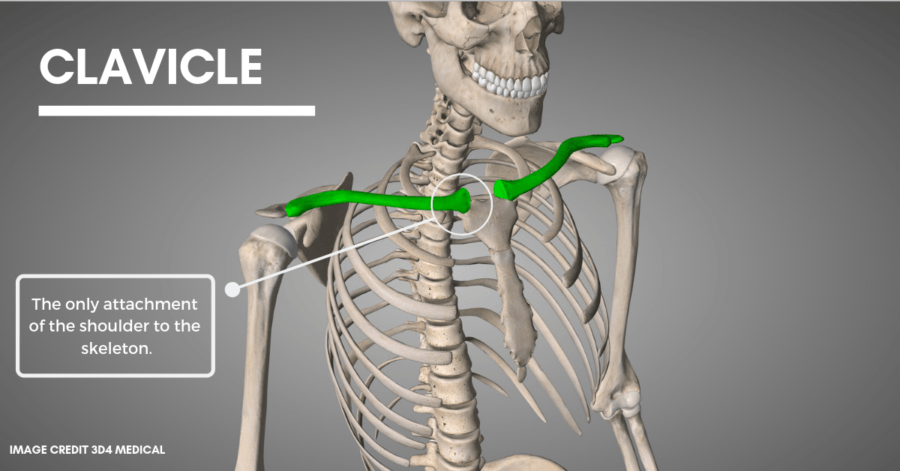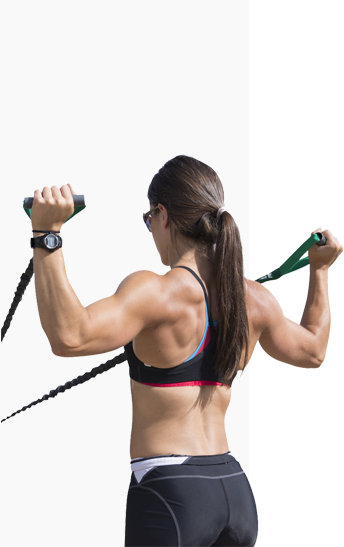Everything You Need to Know About the Shoulder

Consider this article the cliff notes for a Shoulder 101 course. It will cover the assembly and mechanics, but not too sciency or overly complicated.
Using this knowledge you’ll be ready for future articles aimed to fix your shoulder hang-ups.
Shoulder Anatomy– “The Framework”
First, get to know the bones of your shoulder. They are the scaffolding that supports the entire structure, similar to a wood frame for a house.
Starting at the ground floor, you’ve got a rib cage. The bony structure designed to protect your internal organs, but also a good place to attach your arms onto.

Although, as you will learn shortly, the shoulder is not tightly fixed to the rib cage, which is all part of the design. There’s only a single bony attachment, which means less restriction and freedom to glide around the contours of the rib cage. It’s like a sailboat loosely tied to a dock, free to float around, only bound by the single anchor point.
Now, to add the arms you need three more bones, together they make up the shoulder complex.
1. The Clavicle
The first piece is the clavicle, often referred to as the collarbone. It’s a support beam of sorts, forming the one bony attachment of the shoulder to the frame of the body.

2. The Scapula
Next is the scapula, also called the shoulder blade; or if you’re into slang, you can call it the scap.
The scapula hangs off the end of the clavicle and against the rib cage, held there by 17 different muscles. Those muscles act as guide-wires, pulling the shoulder blade into different positions.
On the outer corner of the triangle is the shoulder socket (you’ll see later, it isn’t much of a socket.)

Before moving onward, take a moment and move your shoulder blade around a bit. Notice how the arm moves along with it!
I promised not to get too technical, but the term used to describe how the scapula and arm move together is scapulo-humeral rhythm. It has a nice ring to it, but it also provides meaning about how the two bones work together.
The key word here is rhythm. A word to describe the movement of two things in synchrony.
This is all too important for the shoulder! The scapula and arm must work together as a team, otherwise, it’s just a half working shoulder. What I’m getting at, is your fix for shoulder pain, or building arm strength, must include the muscles that move the scapula as well.
3. The Humerus

Then there is the arm bone (or the medical term is the humerus.)
It has a ball on the end which attaches into the shoulder socket. The benefit of a ball and socket is lots of movement. Make a fist and cover it with your other hand— notice how it can slide and glide in many different directions.
But as hinted at earlier, it’s not actually a socket. The head of the arm bone is much larger than the socket, often described like a golf ball sitting on a tee.
The advantage of this is again movement! The shoulder isn’t bound by hard or immovable things like bones.

“Holding it Together”
Shoulder anatomy is that simple— only 3 bones! All held together by “tape and rubber bands.”
The tape describes the static stabilizers. Things that don’t move and aren’t all that stretchy. They do a good job of holding things in place, kinda like tape. The most talked about static stabilizers are the shoulder ligaments and the labrum.
The rubber bands describe muscles and their tendon attachment (technical folks refer to the rubber bands as the dynamic stabilizers.) They hold things together, but also lengthen and shorten, which makes the arm move.
The Shoulder Trade-Off
To summarize everything to this point, you can see the shoulder is made for movement.
It can work in many different directions. Along with that, it can go fast, for things like throwing; or it can be strong to lift weights and carry bags of dog food; or it can be very precise to catch something tossed your way.
Compared to the hip, it’s much less clunky and robotic. Free to wave around like those tube dancers that jive in front of used car lots.
As with anything though, there is a trade-off. All that movement freedom can bring about problems. First of all, it’s prone to become unstable when the things holding it together aren’t working right(remember…tape and rubber bands.) Secondly, just like any complex machine, there are more ways that things can go wrong.
We’ll get to the breakdowns in other articles, but for now, let’s cover how it works when things go right!
Movement of the Shoulder
There are lots of shoulder muscles! Each one has an action and combines with other muscles for additional actions.
But you don’t need to know any of those things!
More important are the principles behind shoulder movement. Let’s break those down for small movements and big movements.
Small Movements
These movements are performed close to your body with loads that aren’t too heavy. Everyday tasks like picking up a coffee cup or working at a desk.
The little moves happen mostly by the ball of the arm moving in the socket. These actions mostly rely on the four smaller shoulder muscles around the joint called the rotator cuff. They connect in a circular pattern around the ball of the shoulder joint to move it around.
Big Movements
Now things get a bit more complex. As movements progress away from the body or overhead, it requires more moving pieces.
Things like washing your hair, reaching into the backseat of the car, or opening the overhead bin on an airplane, only so much can happen with the ball moving around the socket.
To get that extra range of motion, the scapula needs to move to free up additional ranges of motion. For example, reach as far forward as you can, and you should feel the scapula wrap around the body; or pull your elbows back and notice how the scaps squeeze together.
Pretty easy right? Well, not so fast!
There is a major scapula movement that happens when bringing your arm overhead. Several muscles pull from opposing sides to pivot the scap for this action to happen. This aligns the shoulder blade with the elevated arm bone, creating a stable support structure, creating a base for the long crane arm.

And do you feel like you’re tight? Stuck in your range of motion, even without much weight? That’s often because the scapula isn’t moving enough to allow that range of motion.
Even Bigger Movements
What about moving heavy weight, pull-ups, and throwing fastballs?
There are additional pieces for this high-performance stuff.

First off, these moves usually need full ranges of motion. (Yet again! Moving the scap is important.)

Then with the shoulder in the right position, the rest relies on the prime movers. Those are the workhorses responsible for strength and power. These are the muscles we hit in the gym—things like the pecs, deltoids, and lats.
But the rotator cuff still has an important job to do here too. The muscles of the rotator cuff keep the arm bone in place inside the shoulder socket.
Summing it Up
Working the remote or eating cheeseburgers doesn’t require too much from the shoulder. If this is your only goal, there probably isn’t much to worry about.
But to have an active life, as you can see, there are lots of working pieces that need to be strong and coordinated.
When pain pops up, it’s usually because one of the parts isn’t meeting the demands.
From here, the future articles in this series will apply this understanding of shoulder anatomy and movement, to explain the many shoulder breakdowns and how pain flares ups.
And of course, we’ll show you some ways to fix it.








